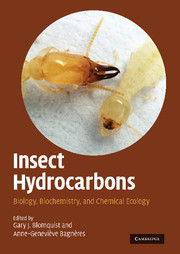Book contents
- Frontmatter
- Contents
- List of contributors
- Foreword
- Acknowledgments
- Part I Chemistry, Biochemistry, and Physiology
- 1 Introduction: history and overview of insect hydrocarbons
- 2 Structure and analysis of insect hydrocarbons
- 3 Biosynthesis of cuticular hydrocarbons
- 4 Molecular biology and genetics of hydrocarbon production
- 5 Site of synthesis, mechanism of transport and selective deposition of hydrocarbons
- 6 Cuticular lipids and water balance
- 7 Chemical taxonomy with hydrocarbons
- 8 Chemical synthesis of insect cuticular hydrocarbons
- 9 Oxygenated derivatives of hydrocarbons
- Part II Chemical Communication
- Index
2 - Structure and analysis of insect hydrocarbons
from Part I - Chemistry, Biochemistry, and Physiology
Published online by Cambridge University Press: 18 May 2010
- Frontmatter
- Contents
- List of contributors
- Foreword
- Acknowledgments
- Part I Chemistry, Biochemistry, and Physiology
- 1 Introduction: history and overview of insect hydrocarbons
- 2 Structure and analysis of insect hydrocarbons
- 3 Biosynthesis of cuticular hydrocarbons
- 4 Molecular biology and genetics of hydrocarbon production
- 5 Site of synthesis, mechanism of transport and selective deposition of hydrocarbons
- 6 Cuticular lipids and water balance
- 7 Chemical taxonomy with hydrocarbons
- 8 Chemical synthesis of insect cuticular hydrocarbons
- 9 Oxygenated derivatives of hydrocarbons
- Part II Chemical Communication
- Index
Summary
Hydrocarbons have evolved to play a plethora of roles in insects, primarily serving as a waterproofing cuticular layer and functioning extensively in chemical communication. This chapter will concentrate primarily on the structure and analysis of long-chain hydrocarbons, components with more than 20 carbons and often containing one or more methyl-branches or one or more double bonds. Until very recently, the chain length of cuticular hydrocarbons was thought to vary from a lower limit of about 21 carbons (shorter chain compounds are volatile) up to a maximum of about 50 carbons (Nelson and Blomquist, 1995). However, the apparent upper limit of the chain length of insect hydrocarbons appears to be a limitation based on analytical technique. Surprisingly, insect hydrocarbons with chain lengths above 60 carbans have been reported in a number of species using Matrix-assisted laser desorption/ionization–times of flight (MALDI–TOF) mass spectrometry (Cvačka et al., 2006). A unique feature of insect hydrocarbons, compared to plant surface hydrocarbons, is the number and variety of positions in which methyl branches and double bonds occur. It seems reasonable to speculate that the variety of methyl-branch positions and number and positions of double bonds have evolved to increase the informational content of hydrocarbon mixtures, while still retaining their waterproofing capabilities. Much of this book will concentrate on the informational content of hydrocarbons in insects, and indeed, it is the tremendous increase in our understanding of the numerous roles in chemical communication that cuticular hydrocarbons play which has resulted in the rapid growth of this field. Cuticular hydrocarbons provide insects with the chemical equivalent of the visually variable colored plumage of birds.
- Type
- Chapter
- Information
- Insect HydrocarbonsBiology, Biochemistry, and Chemical Ecology, pp. 19 - 34Publisher: Cambridge University PressPrint publication year: 2010
- 50
- Cited by



